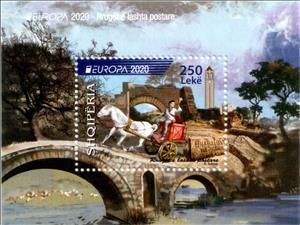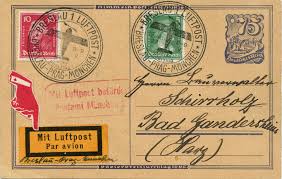Souvenir Sheet: Postal Carriage on Via Egnatia (Albania 2021)
Postal Carriage on Via Egnatia (Albania 2021)
22 February (Albania ) within release Europa (C.E.P.T.) 2020 - Ancient Postal Routes goes into circulation Souvenir Sheet Postal Carriage on Via Egnatia face value 250 Albanian lek
| Souvenir Sheet Postal Carriage on Via Egnatia in catalogues | |
|---|---|
| Colnect codes: | Col: AL 2021-01SS |
Souvenir Sheet is square format.
Dated 2020Also in the issue Europa (C.E.P.T.) 2020 - Ancient Postal Routes:
- Stamp - Post Runner on Via Egnatia face value 150;
- Souvenir Sheet - Postal Carriage on Via Egnatia face value 250;
- Stamp - Postal Carriage on Via Egnatia face value 250;
- Booklet - Post Runner and Postal Carriage on Via Egnatia face value 400;
- Booklet Pane - Post Runner and Postal Carriage on Via Egnatia face value 400;
- Full Pane - Post Runner on Via Egnatia face value 32*150;
Souvenir Sheet Postal Carriage on Via Egnatia it reflects the thematic directions:
A bridge is a structure built to span physical obstacles without closing the way underneath such as a body of water, valley, or road, for the purpose of providing passage over the obstacle. There are many different designs that each serve a particular purpose and apply to different situations. Designs of bridges vary depending on the function of the bridge, the nature of the terrain where the bridge is constructed and anchored, the material used to make it, and the funds available to build it.
The horse (Equus ferus caballus) is one of two extant subspecies of Equus ferus. It is an odd-toed ungulate mammal belonging to the taxonomic family Equidae. The horse has evolved over the past 45 to 55 million years from a small multi-toed creature, Eohippus, into the large, single-toed animal of today. Humans began to domesticate horses around 4000 BC, and their domestication is believed to have been widespread by 3000 BC. Horses in the subspecies caballus are domesticated, although some domesticated populations live in the wild as feral horses. These feral populations are not true wild horses, as this term is used to describe horses that have never been domesticated, such as the endangered Przewalski's horse, a separate subspecies, and the only remaining true wild horse. There is an extensive, specialized vocabulary used to describe equine-related concepts, covering everything from anatomy to life stages, size, colors, markings, breeds, locomotion, and behavior.
Postal history is the study of postal systems and how they operate and, or, the study of the use of postage stamps and covers and associated postal artifacts illustrating historical episodes in the development of postal systems. The term is attributed to Robson Lowe, a professional philatelist, stamp dealer and stamp auctioneer, who made the first organised study of the subject in the 1930s and described philatelists as "students of science", but postal historians as "students of humanity". More precisely, philatelists describe postal history as the study of rates, routes, markings, and means (of transport).



